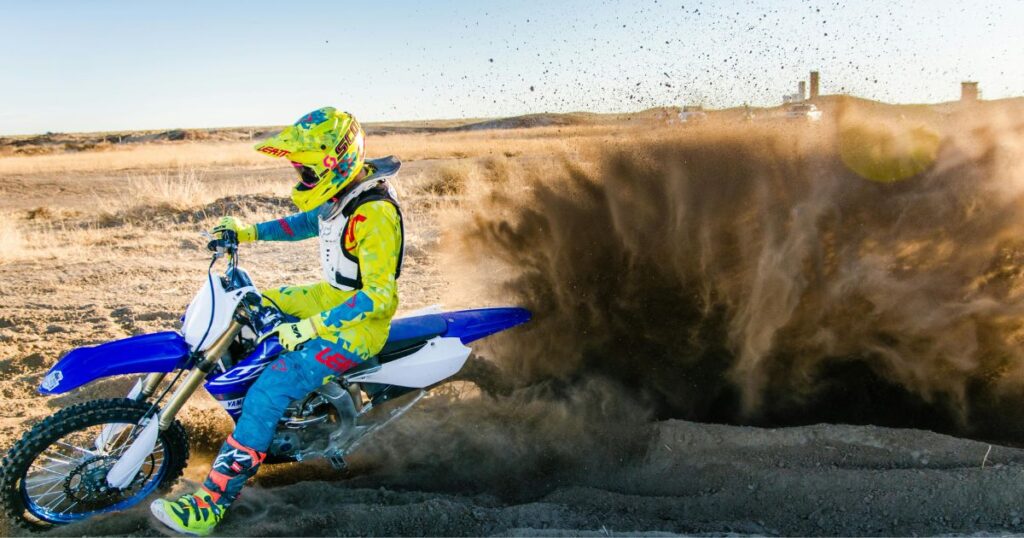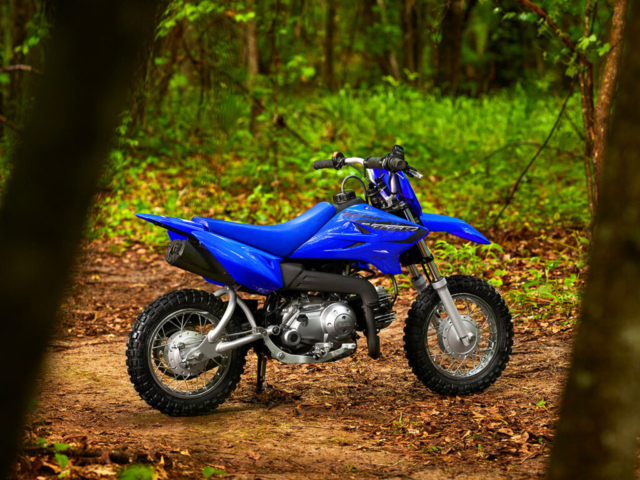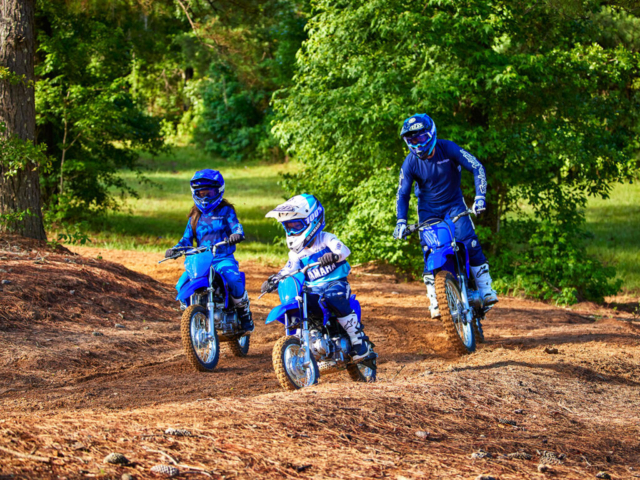Which is better for your children or grandchildren, between the PW50 and TTR50? PW50 vs TTR50 is the most common debate when you are trying to buy the first dirt bike for your little one.
The most basic difference is in the engine stroke, where the PW50 has a 2-stroke engine, while the TTR50 features a 4-stroke engine. This variation affects the combustion process and overall engine efficiency, affecting factors such as power delivery and fuel consumption.
What Age is the PW50 for?
Although this depends on the size of your kids, considering the smaller height of the PW50 bike, it is best suited for riders aged 3 to 7 or younger.
The PW50 has a seat height of 18.7 inches, which is about 3.2 inches taller than the TTR50.
What Age is the TTR50 for?
The TTR50, with a slightly higher height than the PW50, is specifically designed for taller riders aged 4 to 7 years.
Top Speed of PW50?
It has a top speed of around 30 mph and can go from 0-60 mph in approximately 10 seconds. However, the speed can vary depending on the weight of the rider and the condition of the trail.
Top Speed of TTR50?
The top speed of TTR50 is around 30 to 32 mph in 10 seconds.
PW50 vs TTR50 engine
Both the PW50 and TTR50 come with single-cylinder engines. The PW50 has a 2-stroke engine, while the TTR50 has a 4-stroke engine. So, the PW50 engine is more powerful than the TTR50 engine.
The engine configuration of the PW50 includes a reed valve system, while the TTR50 adopts a SOHC (single overhead camshaft) valve configuration with two valves per cylinder. The PW50 has a compression ratio of 6.0:1, whereas the TTR50 has 9.5:1.
In terms of the starting mechanism, the PW50 comes with a kick starter, while the TTR50 includes an electric starter, which may be a convenience for new riders.
In terms of fuel, the PW50 operates on a gas/oil-injected system, while the TTR50 runs entirely on gas. Both bikes require regular fuel and use Mikuni carburettors, with the PW50 having a slightly larger carburettor size at 12 mm compared to the TTR50’s 11 mm.
Suspension
Both the Yamaha PW50 and Yamaha TTR50 showcase robust suspension systems designed to handle off-road terrain and deliver a smooth riding experience.
Size – One is Smaller Than the Other
The TTR50 is longer than the PW50. The increased height of the TTR50 can be beneficial for riders who are a bit tall, providing better visibility and control during their riding experience.
A higher ground clearance of TTR50 ( 5.3 inches ) allows motorcycles to navigate uneven and rough terrain more effectively.
How Much Do They Cost?
The price of PW50 and TTR50 is almost the same. You may have to pay $50 more for TTR50.
PW50 Photos
TTR50 Photos
PW50 vs TTR50: Specification
GENERAL INFORMATION
| # | PW50 | TTR50 |
| Manufacturer | Yamaha | Yamaha |
| Model Year | 2024 | 2024 |
| Model | PW50 | TTR50 |
| Model Code | PW50R2C | TT-R 50E |
| Available Color | Team Yamaha Blue | icon blue |
| Warranty | 3 months (Limited Factory) | 3 months (Limited Factory) |
| Price | $1,849* | $1,899 |
ENGINE
| # | PW50 | TTR50 |
| Cylinders | 1 | 1 |
| Engine Stroke | 2-Stroke | 4-Stroke |
| Cooling | Air | Air |
| Valves | 2 | |
| Valves Per Cylinder | N/A | 2 |
| Valve Configuration | Reed Valve | SOHC |
| Compression Ratio | 6.0:1 | 9.5:1 |
| Starter | Kick | Electric |
| Fuel Type | Gas / Oil Injected | Gas |
| Fuel Requirements | Regular | Regular |
| Carburetion | Standard | Standard |
| Carburetion Brand | Mikuni | Mikuni |
| Fuel Injector | No | No |
| Carburetor | Yes | Yes |
| Number Of Carburetors | 1 | 1 |
| Carburetion Type | Carburetor | Carburetor |
| Parental Controls | Standard | Standard |
| Speed Governor | Yes | Yes |
| Bore (mm/in) | 40 / 1.58 | 36 / 1.42 |
| Stroke (in/mm) | 1.54 / 39.2 | 1.91 / 48.6 |
| Displacement (cc/ci) | 49 / 3 | 49 / 3 |
| Carburetor Size (mm) | 12 | 11 |
DIMENSIONS
| Specification | PW50 | TTR50 |
| Length (in/mm) | 49 / 1244.6 | 51.4 / 1305.6 |
| Width (in/mm) | 24 / 609.6 | 23.4 / 594.4 |
| Height (in/mm) | 27.8 / 706.1 | 31.3 / 795 |
| Seat Height (in/mm) | 18.7 / 475 | 21.9 / 556.3 |
| Wheelbase (in/mm) | 33.7 / 856 | 36.4 / 924.6 |
| Ground Clearance (in/mm) | 3.7 / 94 | 5.3 / 134.6 |
| Wet Weight (lbs/kg) | 90 / 40.8 | 128 / 58.1 |
| Fuel Capacity (gal/l) | 0.5 / 1.9 | 0.8 / 3 |
| Engine Displacement to Weight(cc) | 0.54 | 0.38 |
SUSPENSION
| Front Suspension Type | Telescopic Fork | Telescopic Fork |
| Rear Suspension Type | Twin Sided Swing Arm | Twin Sided Swing Arm |
| Number Rear Shock Absorbers | 2 | 1 |
| Air Adjustable | No | No |
| Front Suspension Size (in/mm) | 1 / 26 | 0.9 / 22 |
| Front Travel (in/mm) | 2.4 / 60.9 | 3.8 / 96.5 |
| Rear Travel (in/mm) | 2 / 50.8 | 2.8 / 71.1 |
WHEELS AND TIRE
| Specification | PW50 | TTR50 |
| Tube / Tubeless | Tubed | Tubed |
| Front Wheel Diameter | 10 | 10 |
| Rear Wheel Diameter | 10 | 10 |
| Front Wheel Width (in) | 2.5 | 2.5 |
| Rear Wheel Width (in) | 2.5 | 2.5 |
| Front Tire (Full Spec) | 2.50-10-4PR | 2.50-10-4PR |
| Rear Tire (Full Spec) | 2.50-10-4PR | 2.50-10-4PR |
BRAKES
| Specification | PW50 | TTR50 |
| Front Brake Type | Drum | Drum |
| Rear Brake Type | Drum | Drum |
| Front Brake Diameter (in/mm) | Not specified | 3.2 / 80 |
| Rear Brake Diameter (in/mm) | Not specified | 3.2 / 80 |
Conclusion
The primary difference between both the bikes is the engine stroke, the PW50 has a 2-stroke engine and the TTR50 has a 4-stroke engine. This difference affects aspects such as power delivery and fuel consumption, thereby affecting the overall riding experience.
The PW50, with its shorter height, is generally recommended for riders ages 3 to 7 years or younger, while the TTR50, designed for taller riders, is specifically tailored for ages 4 to 7 years. Has gone.


